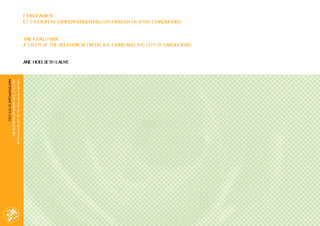| dc.description.abstract | Sjøen og de gode havneforholdene la grunnlaget for Sandefjord slik vi kjenner byen i dag. Sjørelaterte næringer har gjennom historien vært avgjørende for byens utvikling i form av trelast, sjøfart, kurbad og hvalfangst. Bykjernen ble etablert tilbaketrukket fra havnen, og der ligger den fortsatt. Sjøen og havneområdet er en stor potensiell ressurs for dagens by. Dårlige strukturelle sammenhenger og manglende opparbeiding hindrer sentrum i å oppnå kontakt med sjøen. Å knytte byen til sjøen har vært et mål for Sandefjord i mange år, og det har vært gjennomført flere arkitektkonkurranser i området uten at det har gitt tydelige resultater. Målet for denne oppgaven er å knytte byen til fjorden. En vurdering av de eksisterende strukturene danner grunnlag for videre utvikling. Infrastrukturen i området skaper tydelige barrierer, hvorav ferjeterminalen og Strandpromenaden har størst innvirkning. Badeparken er en stor potensiell ressurs, men til tross for en beliggenhet nær både havnen og bykjernen er sammenhengen til omgivelsene dårlig.
I det endelige planforslaget benyttes grønnstrukturen til å knytte byen og sjøen sammen. Ferjeterminalen og biltrafikken må vike for å gi plass for ny byutvikling. I Fjordparken skapes en sterk og sammenhengende grønnstruktur hvor byen og sjøen møtes. The sea and the attractive port conditions formed the basis for the city of Sandefjord as we know it today. Through the history, sea related industries have been decisive for the city’s development, such as timber, shipping, spa and whaling. The heart of the city was founded some distance behind the harbour area, where it is still situated today. The sea and the harbor area have a great potential value to the city. Structural incoherence and a lack of content prevents the city from connecting to the sea. Connecting the city to the sea has been an aim to Sandefjord for several years, and several archictural competitions has been carried through without any considerable results.
The purpose of this paper is to establish contact between the fjord and the city.
An evaluation of the existing structures forms the basis for the further development. The area’s infrastructure makes up barriers, of which the ferry terminal and the Strandpromenaden road has the greatest impact on the area. Badeparken has a high potential value to the city, but despite of a site close to both the city centre and the sea, the park is poorly connected to it’s surroundings.
In the final plan proposal, the green structure is made use of, to unite the city and the sea. The ferry terminal and the car traffic must give way to the new city development. In the new Fjord Park, the city and the fjord meets in a strong, coherent green structure. | en_US |
